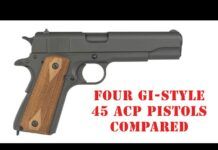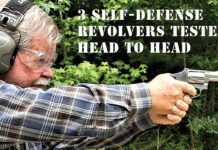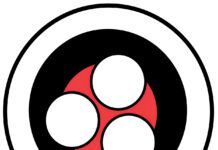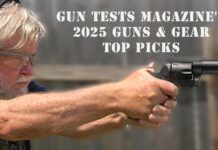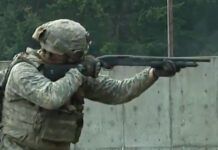(GunReports.com) — Kel-Tec CNC Industries started out as a machine shop in 1991 and began manufacturing firearms some four years later. Small-caliber pistols with polymer frames, locked breech actions, and DAO triggers continue to be Kel-Tec’s bread and butter.
The P11 is a 9mm handgun with a 3.1-inch barrel. Capacity was 10+1, thanks to a double-column magazine. The suggested retail price of the base model was only $314 and featured a blued slide. Our P11 carried a hard-chromed slide and cost $368, but the same gun was available for $355 should you choose a P11 with a Parkerized finish.
The inexpensive Kel-Tec P11 shared at least one design concept found on some more expensive pistols. The P11 slide did not ride primarily on polymer rails. An aluminum frame was set into the polymer receiver, which also housed the firing mechanism. Removing the top end to get a better look inside began with removing the magazine, emptying the chamber and locking back the slide. The assembly pin, which was on the left side directly above the trigger, was now in position to be removed. It was designed to be plucked out of the frame with the use of a case rim. (Almost any caliber will do.) The guide rod was polymer, and the recoil system used two coil springs one over the other. Replacing the slide meant fitting it to the aluminum rails, locking it back, and pushing the barrel all the way forward to expose the cut in the barrel to the assembly pin hole. Once the pin was inserted, the slide was unlocked and moved forward to its rest position.
The Kel-Tec P11 came in a very small cardboard box with an owner’s manual and a padlock. The only magazine supplied was a 10-round model, but according to the website some P11s were shipped with nine-round magazines. The grip on this pistol is short, so most shooters will find it difficult to grasp the P11 with more than the middle and ring fingers across the front strap. Still, we had no difficulty stabilizing the P11 on the shooting bench, and there were no malfunctions.
We found performance with the 124-grain Speer Gold Dot hollowpoints to be more than satisfactory. Our five-shot groups ranged from 1.6 to 2.4 inches measured center to center. Accuracy with the other test rounds was disappointing. In each case average group size was 3.9 inches.
In our practical test at 7 yards, the results showed two strong characteristics. Thirteen of the 18 total shots were off center to the left. The central A zone had only three hits to the right of center, with the majority of bullet holes grouped 2 to 3 inches to the left of point of aim. One shot dropped all the way down to the C zone, representing the groin area of the humanoid silhouette. All but two of our head shots were left of center, and they were also much lower than intended.
In truth, this was a shooting problem we attributed to the operator. But why did it happen? First let’s analyze the movement of the trigger as we did before. Trigger span at rest from the center of the trigger face to the nearest edge of the back strap measured 2.9 inches. There was 0.1 inch of take-up before the trigger finger met resistance. Ignition was at a span of 2.2 inches. Upon release, the firing mechanism did not reset until the trigger had returned nearly all the way back to the initial point of resistance. This meant that the shooter had to withstand a measured 10 pounds of pressure throughout a movement covering approximately 0.6 inch, all the while steering the front sight to proper alignment. Obviously, fatigue became a factor.
17-1-Kel-1_5.jpgOur measurement of Trigger Span was from the center of the trigger at rest to the nearest edge of the backstrap. But we also used a dial caliper to measure the distance the trigger had to be moved for taking up initial slack, breaking the shot, reset and the limits of overtravel (shown).



